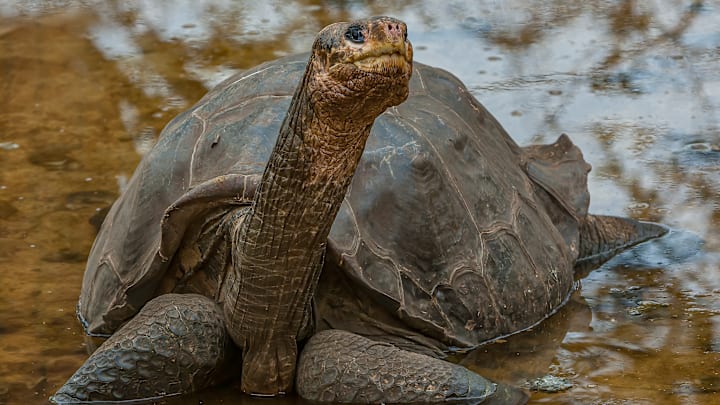Every species that’s ever gone extinct has had an endling: a being that represents the last living member of its kind. While countless endlings have blinked out of existence before we got a chance to document their species, others have gained worldwide recognition. Here are some of the most famous animals that signaled the end of their eras.
- Booming Ben the Heath Hen
- Martha the Passenger Pigeon
- Celia the Pyrenean Ibex
- Toughie the Rabbs’ Fringe-Limbed Tree Frog
- Lonesome George the Pinta Island Tortoise
- The Last Kauaʻi ʻōʻō
Booming Ben the Heath Hen

The extinction of the heath hen came at the end of a hard-fought preservation effort, making its story even more tragic. After their habitat was changed by colonizers, heath hens, a subspecies of the greater prairie chicken, had all but disappeared from the northeastern U.S., and by 1870, the last birds that remained lived on Martha’s Vineyard in Massachusetts. But conservationists weren’t about to let the species die out so easily: A preserve was created for the struggling population and by 1916 their numbers had grown from 100 to 2000. Unfortunately, all that progress was wiped out that May, when a wildfire burned through their habitat and led to the deaths of hundreds of birds. Despite efforts to rebuild the group, by 1929 only one heath hen remained: a male named Booming Ben. He was last spotted in 1932, which means that unlike other animals on this list, his death wasn’t documented.
Martha the Passenger Pigeon

Long before Martha, passenger pigeons were the most abundant birds in North America, flying in flocks of hundreds of millions and eclipsing the sun for hours at a time. But by the turn of the 20th century, their population shrunk from roughly 6 billion to just a few captive specimens. Deforestation and game hunting helped fuel their dramatic decline. Martha was born in the Cincinnati Zoo and lived there for 29 years before passing away in 1914, marking the end of her kind. After she died she was immediately placed on ice and shipped to the Smithsonian in Washington, D.C., where her stuffed body can still be viewed today.
You May Also Like ...
- 10 Tragic Stories of Extinct Animals
- Does De-Extinction Actually Work?
- 8 Animals That Recently Went Extinct
Add Mental Floss as a preferred news source!
Celia the Pyrenean Ibex

Celia’s status as an endling is up for debate. Her body was found in Spain in 2000, leading biologists to declare the Pyrenean ibex extinct following years of hunting pressures and competition from domestic cattle. But that wasn’t the end of her story: Using skin samples collected shortly after her death, scientists successfully cloned Celia in 2003, marking the first time a species was “brought back” from extinction. The cloned ibex died just minutes after it was born as a result of a lung defect, so sadly the effort to revive the Pyrenean ibex was short-lived.
Toughie the Rabbs’ Fringe-Limbed Tree Frog

Toughie wasn’t just the last of the Rabbs’ fringe-limbed tree frogs—he was the first of its kind ever discovered. Researchers found him in Panama in 2005 during a rescue effort to save wild amphibians from a deadly skin fungus spreading through the jungle. He was given a new home in Atlanta Botanical Garden and named Toughie—a suggestion that came from the garden’s amphibian conservation coordinator’s 2-year-old son. More frogs like Toughie were eventually found (or heard croaking in the wild), and the newly discovered species Ecnomiohyla rabborum was officially recognized in 2008. But the frogs died out within years, both in the wild and in captivity, and when Toughie died in 2016, the species likely died with him.
Lonesome George the Pinta Island Tortoise

Few endlings (or at least few that we know of) held on to their status as the last of their species for as long as Lonesome George. The Pinta Island tortoise was first seen on his namesake island in the Galápagos in 1971. Initially, his discovery inspired new hope for the fate of the species: Before George, it was believed that the tortoise had been driven to extinction by hungry whalers and fur traders making stops at the island. Conservationists attempted to find a surviving female Pinta Island tortoise for George to mate with, and when that plan failed, they set him up in pens with female tortoises that were closely related to the species. These breeding efforts were unsuccessful, and in 2012, Lonesome George passed away in captivity on California’s Santa Cruz Island without having produced any offspring. It’s estimated that he had been over 100 at the time of his death. Today, his preserved remains are on display at the Charles Darwin Research Station in the Galápagos.
The Last Kauaʻi ʻōʻō

In 1987, American ornithologist H. Douglas Pratt captured the song of a male Kauaʻi ʻōʻō bird (Moho braccatus) on his microphone. The honeyeater’s mournful cry through the Hawaiian jungle became even more haunting with context. At the time of recording, the bird was the last of its kind. The species had been pushed to the brink of extinction by habitat loss and invasive species like egg-eating rats. Now, the last Kauaʻi ʻōʻō's call lives on in the archives of Cornell University’s department of ornithology. In 2009, a digitized version of the recording was uploaded to YouTube, where more than 4.5 million people have listened to it in the years since.
A version of this story originally ran in 2021; it has been updated for 2025.
